It's no secret. The quality of customers' experiences directly impacts customer loyalty, likelihood to refer, and propensity to purchase. Beyond these important business outcomes, delivering quality customer experiences has also been shown to be an effective strategic response to the increasingly prevalent problem of product commoditization. Knowing, however, is hardly a substitute for doing. Despite the widespread recognition that offering quality customer experiences is critical, too many companies still struggle to deliver experiences that reinforce the brand promise, that support positive word of mouth and a strong reputational presence in the marketplace, and that ultimately strengthen customers' trust in the business.
Yet, many other companies are succeeding in delivering quality customer experiences and in achieving these and other beneficial outcomes.
The key question, then, is clear: What distinguishes the "strugglers" from the "succeeders"?
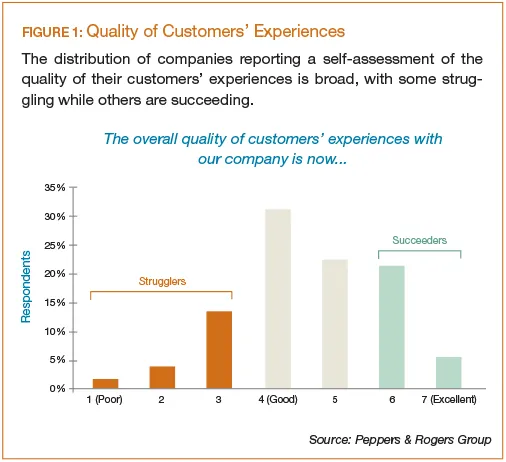
To pursue this question, Peppers & Rogers Group conducted research this past spring among subscribers to its publications. A total of 362 provided their perspectives by completing an online questionnaire. A majority (57 percent) of these respondents hold director or higher positions within their company, and most (53 percent) work for B2B2C organizations.
The research sought to gain insight into the:
- Current state of customer experience quality
- Organizational conditions for exceptional customer experiences
- Capabilities that enable the delivery of customer experiences
- Level of customers' trust in the company
- Business benefits gained as a result of delivering quality customer experiences
Current state of customer experience quality
When asked to rate the overall current quality of their customers' experiences, companies appear across the entire spectrum ranging from poor to excellent (see Figure 1). A subset of these companies are "strugglers"—those for which the quality of their customers' experiences is less than good (19 percent). At the other end of the continuum, however, another subset emerged—the "succeeders," those for which the quality of their customers' experiences is excellent or nearly excellent (27 percent).
This research documents a number of distinguishing characteristics that differentiate succeeders from strugglers, including the organizational enablers of customer experience excellence.
Organizational enablers
The research explored two key organizational enablers, the first of which revealed whether a respondent's company has a formal, written definition of the term "customer experience." The existence of clear definitions provides three key benefits.
Vocabulary. Only when all employees across all functional areas—from senior management through frontline personnel—share a common understanding of the term "customer experience" can meaningful and purposeful strategic planning and tactical execution occur. Visibility. A written definition of "customer experience," when commonly communicated, provides top-of-mind awareness of its ongoing importance to the success of the company.
Visualization. A concrete understanding of "customer experience" allows employees (especially those with direct customer-facing responsibilities) to have an internal image of the "end-in-mind," guiding their decisions at each moment of truth.
Succeeders were about three times more likely to agree1 that their company has written a formal definition of the term "customer experience" than strugglers (see Figure 2). However, it is an area of improvement, since less than half actually have one.
A second organization enabler that distinguishes succeeders from strugglers is the existence of a budget dedicated to the improvement of the customers' experience.
While only about one third of succeeders agree that such a budget exists in their company, its prevalence is nearly three times of that found among strugglers (see Figure 2).
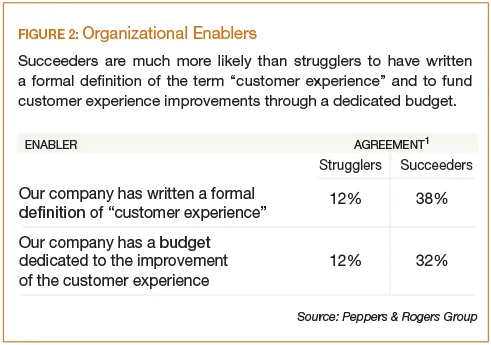
Capabilities
To deliver high-quality customer experiences, a company needs excellent capabilities in four realms:(1) organizational, (2) process,(3) information and technology, and (4) measurement.
1. Organizational. A majority of succeeders rate each of the organizational capabilities examined in this research as excellent2 within their companies—far exceeding the prevalence of strugglers in these same areas (see Figure 3, page 40). The difference between the two is particularly large for empowering employees to treat customers right, a capability rated as excellent2 by nearly four out of five of all succeeders. Enabling that empowerment with customized tools for enhancing customers' experiences is also a characteristic of over half of all succeeders. "Empowered and enabled employees are exactly what customers are demanding, also, as their expectations of better service continue to rise," explain Don Peppers and Martha Rogers, Ph.D., founding partners of Peppers & Rogers Group. "Customers want the people they deal with at the companies they buy from to be capable of helping them, whether this involves fixing a problem, or selling an additional product, or making an exception to corporate policy because the customer's circumstances are exceptional. This means customers expect employees to have not just the authority but also the tools, the information, and the training necessary to deal with whatever the issue is."3
2. Process. Succeeders excel at providing prompt and effective resolution of complaints, an area of excellence2 that is nearly absent among strugglers (see Figure 3, page 40). Addressing complaints successfully is critical, because research has demonstrated that when done in a timely and thoughtful manner, it may actually increase customer loyalty. While succeeders are substantially more likely than strugglers to report excellence in delivering seamless and consistent service across channels, it is nonetheless an area requiring attention. In today's world, channels and their usage by customers have proliferated, creating a new set of challenges for designing and delivering high-quality customer experiences. Unfortunately, less than half of succeeders have achieved excellence in this facet of customer experience, as compared to none of the strugglers.
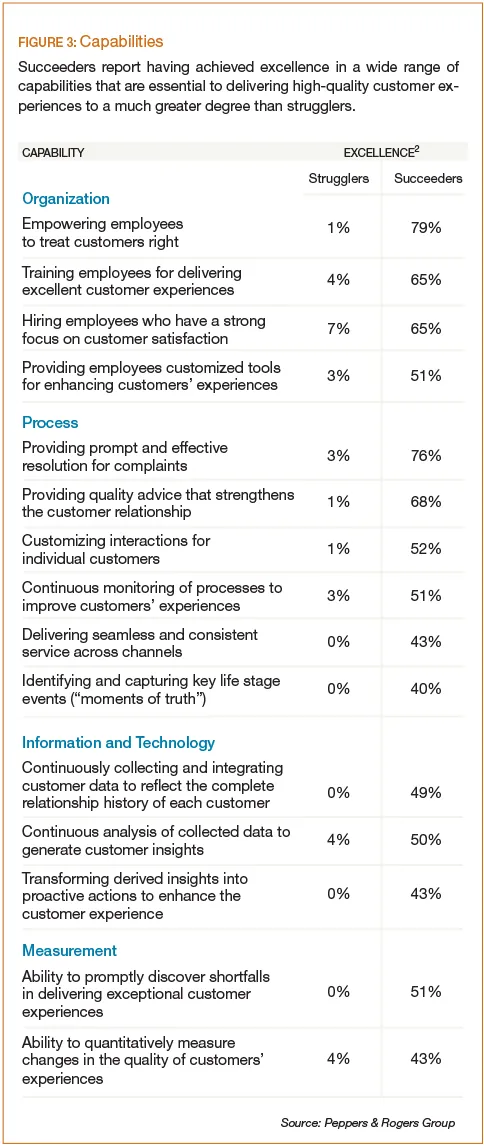
3. Information and technology. Continuously collecting and integrating customer data to reflect the complete relationship history of each customer is a capability rated as excellent2 by nearly half of all succeeders. In contrast, none of the strugglers consider their performance in this area as excellent. This process of becoming "smarter and smarter" about each individual customer over time is known as a learning relationship. "The more you can get a customer to 'teach' you about his needs—provided you can actually meet them with an increasing degree of customization or an increasing amount of service—the more loyal that customer will become, because he won't want to have to expend the time or take the risk to reteach some other firm what he's already taught you," Peppers and Rogers explain. "In effect, a learning relationship dramatically increases a customer's cost of switching companies or brands. Success depends on learning how to serve this particular customer better than any of your competitors can serve him, because you know more about him, through direct interaction, than anyone else can know."4
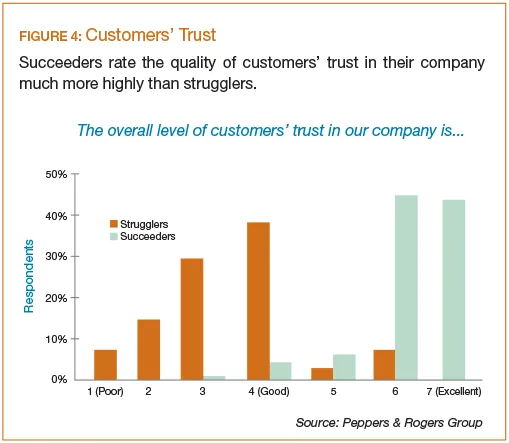
4. Measurement. The ability to know (rather than to speculate) about the state of customers' experiences enables fact-based decision making and wisely prioritized investments. Succeeders' ability to quantitatively measure changes in the quality of customers' experiences distinguishes them from strugglers (see Figure 3). However, even among the succeeders, less than half report that these measurement abilities are excellent. A similar pattern emerges when considering the timeliness of the measurement of customers' experiences. About half of the succeeders report that their ability to promptly discover shortfalls in delivering exceptional customer experiences is excellent in contrast to none of the strugglers.
Trust and business outcomes
A key consequence of delivering high-quality customer experiences is the impact that it has on building customer trust. The association between customer experience and trust is too infrequently noted or discussed among marketing professionals, but that linkage may be the most important basis for justifying investments in improving customers' experiences. "Customers prefer to deal with companies they trust, so if you want to sell more, to more customers, then you have to increase the level of trust your customers have in you," say Peppers and Rogers. "It's really that simple. It would be hard to name any management task more important than simply building and protecting your reputation among customers and prospective customers, so that they continue to keep you in business."3
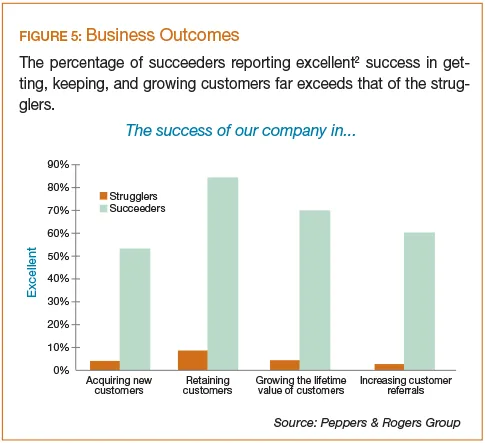
Among participants in this research, the impact of the quality of customer experience on customer trust is substantial (see Figure 4). The mean level of customers' trust reported by succeeders (6.3) is almost twice as great as that reported by strugglers (3.4), with no succeeders rating the level of their customers' trust as poor and not a single struggler rating it as excellent.
It is therefore not surprising that the percent of succeeders reporting excellent success in acquiring customers, retaining customers, growing the lifetime value of customers, and increasing customer referrals far outpaces that of the strugglers (see Figure 5). As compared to strugglers, the prevalence of succeeders reporting excellent success in acquiring customers is about 12 times greater; in retaining customers, 10 times greater; in growing the lifetime value of customers, 16 times greater; and in increasing customer referrals, 20 times greater.
Conclusion
The quality of customers' experiences varies widely across the companies with which they choose to interact. Companies' ability to deliver high-quality customer experiences is correspondingly broad, with succeeders demonstrating superiority across a range of organizational, process, information and technology, and measurement realms as compared to strugglers. When the quality of customers' experiences is high, their trust in a company is correspondingly strong. That translates into superior performance in getting, keeping, and growing a company's most scarce and precious resource: the customers it has today, and those it may secure tomorrow.















